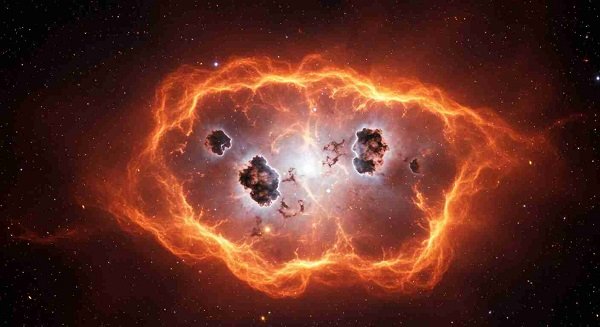Scientists have discovered unexpectedly cold clouds—described as “ice”—nestled within the scorching Fermi bubbles above and below our galaxy’s center, hinting at a dramatic eruption just one million years ago.
🚨 What Are Fermi Bubbles?
Stretching more than 25,000 light‑years above and below the Milky Way’s plane, the Fermi bubbles were first detected in 2010 via gamma‑ray observations. These vast lobes are believed to have been created by powerful outflows from the galaxy’s central supermassive black hole (Sagittarius A*) or a burst of star formation.
Until now, astronomers thought the bubbles contained only extreme environments—hot gas exceeding a million degrees Fahrenheit. But new findings reveal a surprising twist.
A Cold Surprise in a Hot Environment
Using the Robert C. Byrd Green Bank Telescope in West Virginia, researchers have detected compact pockets of cold, dense hydrogen—essentially cosmic “ice”—embedded within the bubbles jic.ac.uk+5smithsonianmag.com+5kmowon.blogspot.com+5 sciencedaily.com. The temperatures in these regions are drastically lower than expected, clashing with the searing million‑degree surroundings.
That such cold gas survives in this hostile environment is astounding. It suggests these hydrogen clouds have only existed for a short cosmic moment—around one million years. In astronomical terms, that’s almost yesterday. Their survival undermines theories that the bubbles are ancient, slow‑cooling structures.
A Young, Violent Event
The presence of cold gas in the Fermi bubbles forces a reevaluation: the galactic event that created them must have been recent—no older than about 1 million years. This points to a potential explosive episode at the Milky Way’s center—likely a sudden flare of activity from Sagittarius A* or a burst of hyper‑energetic starbirth, known as a starburst.
In either scenario, the energy released would have propelled charged particles far into space, creating the gamma‑luminous lobes we now identify as Fermi bubbles. The new discovery offers a timestamp, anchoring this galactic upheaval in recent cosmic history.
Why This Matters
-
Rewriting Galactic History
This finding transforms our understanding of the Milky Way, painting a picture of a galaxy that’s not quietly aging but still dynamically alive. Documenting an event only a million years old suggests ongoing, large‑scale changes at our core. -
New Clues About Galactic Feedback
These outbursts affect how energy circulates and shapes the galaxy—regulating star formation, moving gas, and influencing the Milky Way’s lifecycle. -
Calibrating Galactic Models
Cold gas in high‑energy zones is hard to simulate. Its presence refines computational models of galactic atmospheres, magnetic fields, and cosmic ray interactions.
The Road Ahead: Mapping the Ice
The next goal for astronomers is fine‑scale mapping of these hydrogen clouds: how big are they? Where exactly do they sit within the bubbles? And might more of them lurk unseen? These answers will come from follow‑up observations using both radio and X‑ray telescopes.
Placing these cold clouds against the backdrop of galactic history helps unravel the cause—be it a black hole’s tantrum or a stellar fireworks show.
Final Word
By uncovering these frozen droplets amid blistering gas, researchers have dramatically reshaped our story of the Milky Way. A cosmic disruption—wild, recent, and powerful—left its imprint, and scientists are only now following its cold breadcrumbs. This isn’t ancient history; it’s a recent event that shows our galaxy is still full of surprises.
Feel free to add visuals such as Green Bank telescope images or archive gamma-ray maps to increase reader engagement. Need SEO tips on titles, meta tags, or suggested headers? I’m happy to help!


